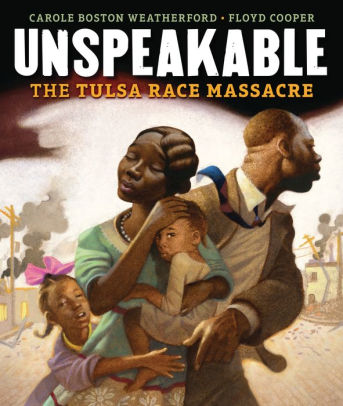Unspeakable exposes a terrible chapter in American history but ends in hope for reconciliation.
Unspeakable: The Tulsa Race Massacre by Carole Boston Weatherford, illustrated by Floyd Cooper. Carolrhoda Books, 2021, 33 pages.

Reading Level: Picture Book, ages 4-8
Recommended for: Ages 7-11
Once upon a time, the Tulsa community of Greenwood was the wealthiest black neighborhood in the USA. Though strictly segregated from whites, the residents had fended very well for themselves, patronizing two theaters, a fine hotel, two newspapers, and fifteen doctors. Good schools, strong families, and thriving churches had created prosperity but also stoked white resentment. In May of 1921, an incident involving a white female elevator operator and a black shoeshine man touched off the worst racial battle in American history. At the end of a bloody weekend, almost 300 blacks lay dead and Greenwood was torched.
The shameful incident was ignored until 1996 when Congress ordered a full investigation. It’s a sad story but ends in hope, as black and white mourners gather in Reconciliation Park to pray for peace. Both author and illustrator share personal recollections of grandfathers and other relatives who experienced the massacre directly or suffered other forms of racial violence. The text, with its “once upon a time” refrain, and the evocative illustrations bring fear, anger, and determination to vivid life.
Overall Rating: 4.5 (out of 5)
- Worldview/moral value: 3.5
- Artistic/literary value: 5
Read more about our ratings here.
Also at Redeemed Reader:
- Reviews: Other outstanding picture books by Carole Boston Weatherford: Box: Henry Brown Mails Himself to Freedom, *How Sweet the Sound: The Story of Amazing Grace, By and By: Charles Albert Tindley, and *Freedom on Congo Square. (* indicates a starred review.)
- Reflection: Why Black History Month?
We are participants in the Amazon LLC affiliate program; purchases you make through affiliate links like the one below may earn us a commission. Read more here.
Support our writers and help keep Redeemed Reader ad-free by joining the Redeemed Reader Fellowship.
Stay Up to Date!
Get the information you need to make wise choices about books for your children and teens.
Our weekly newsletter includes our latest reviews, related links from around the web, a featured book list, book trivia, and more. We never sell your information. You may unsubscribe at any time.
We'd love to hear from you!
Our comments are now limited to our members (both Silver and Golden Key). Members, you just need to log in with your normal log-in credentials!
Not a member yet? You can join the Silver Key ($2.99/month) for a free 2-week trial. Cancel at any time. Find out more about membership here.
2 Comments
Leave a Comment
You must be logged in to post a comment.


Thank you so much for highlighting this book. It looks like a volume to add to our school library — but where is always a dilemma with such material. As with much of African-American history, the subject matter is so deeply disturbing it seems too hard emotionally for younger readers. And yet the format of this book just not what a middle school reader would ever pick up. Is third grade the right moment development ally? Thoughts out there in RR-world…?
The subject matter IS disturbing enough that third grade might be too young. As for older readers, at Redeemed Reader we encourage middle-graders to read picture books, especially if it’s a subject they have no acquaintance with already. I’ve learned a lot from picture books! The combination of illustration and exposition can make a powerful impression. But if you can’t persuade a 6th-grader to pick up Unspeakable, the subject probably won’t be too much for a 4th or 5th-grader, and as mentioned in the review, the story ends with hope for reconciliation.